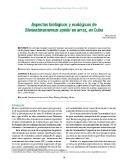Aspectos biológicos y ecológicos de Steneotarsonemus spinki en arroz, en Cuba
Alternative title
Biological and ecological aspects of Steneotarsonemus spinki on rice in Cuba
Description
3 ilus. 5 tab. 6 ref.
Abstract
Se investigó el agente causal de síntomas anormales en panículas de arroz, tales como la presencia de granos vanos y manchados. Se identificó la plaga y se realizaron estudios bioecológicos que incluyeron la duración del ciclo de vida, el movimiento poblacional de la plaga considerando sus depredadores y la distribución de ambos dentro de la planta. Se determinó que el ácaro Steneotarsonemus spinki Smiley (Acari: Tarsonemidae) fue el causante de los daños observados. La duración del ciclo de vida, en condiciones de laboratorio, varió entre 5 y 9 días. La mayor población de la plaga se encontró en las vainas de las hojas 2 y 3 (vainas inferiores), mientras que la población de los depredadores se distribuyó de manera general en las mismas vainas. La fenología del cultivo fue el único factor que influyó significativamente sobre la densidad de S. spinki. Research was performed to investigate the causal agent of abnormal symptoms, such as spotted and unfilled grains, in rice panicles. The pest was identified and bioecological studies, including the duration of the life cycle, population movement of the pest in relation to its predators and the distribution of both, were performed. The mite Steneotarsonemus spinki Smiley (Acari: Tarsonemidae) was determined to be the cause of the damage observed. The duration of the life cycle, under laboratory conditions, ranged between 5 and 9 days. Most of the mite population was found on the sheets of leaves 2 and 3 (lower leaves), whilst the predator population was evenly distributed over the same sheets. The crop phenology was the only factor that significantly influenced the S. spinki density.
Keywords
Publisher
CATIE, Turrialba (Costa Rica)


